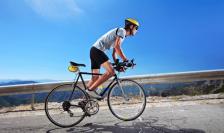Is Sitting on a Bicycle as Bad as Sitting in a Chair?
We’ve all seen the news that long periods of sitting can be detrimental to our health. But what about sitting on a bike? Get-Fit Guy explores the difference between the two and gives you tips to help you avoid injury.
Ben Greenfield
You’ve no doubt seen the news that sitting is the new smoking. Apparently, so has Get-Fit Guy listener and future cyclist Corina, who wrote in asking:

“Lately, everywhere I go I hear that sitting is worse than smoking. I enjoy walking, but I’m getting bored with it and wanted to start riding my bike again. But isn’t that still just sitting? Does that mean I have to pedal standing up to get any benefit?”
Great question, Corina!
Although this is something I discussed in a podcast episode last November, it’s definitely a worthy topic to revisit in this newsletter. After all, it makes sense that if your butt is parked on a bike, it could theoretically be just as bad as sitting in a chair.
But here’s the difference: As I discuss in the episode 7 Ways to Burn Calories by Standing More, sitting down regulates the activity of key fat burning enzymes – primarily because you’re sedentary and not activating any of your little core or leg muscles. But when you’re sitting on a bike, there’s obviously quite a bit going on in your leg muscles – metabolic activity that keeps those fat burning enzymes active.
So metabolically, sitting on a bike isn’t an issue. But biomechanically, bicycling can actually be tough on your body. Both chronic sitting and cycling are often performed in an exaggerated flexed position. As a coach, I frequently work with the cycling population, and I’ve noticed they often complain of neck and upper back pain. The pain usually begins as an ache or a sore muscle, but if left unaddressed, can quickly turn into something more serious – a pinched nerve, loss of range of motion, or a bulging or herniated disc. These often result in surgery.
It’s incredibly important for a cyclist like Corina to become aware of the positions she is putting herself in at work and on the bike. It is equally important to incorporate the appropriate mobility and stability exercises throughout the day to offset the joint and muscular adaptation that occurs from frequent flexed positions. Even if the seat height, handlebars, and size of the bike are optimal, the spine will still be in a flexed position.
If cycling is your preferred cardiovascular activity, at least do it the right way. Make it a point to (like Corina noted) alternate between the seated and the standing position as you ride – but in moderation so that you’re not bouncing up and down like a jack-in-the-box spin instructor.
Also, try to offset some of the biomechanical damage a bike can cause by engaging your thoracic spine when you’re off the bike. Perform exercises such as seated cable rows and foam rolling on the low back with your arms overhead.
Do you have more questions about how to ride your bike without the threat of injury? Head over to Facebook.com/GetFitGuy and ask your questions or join the conversation there!

